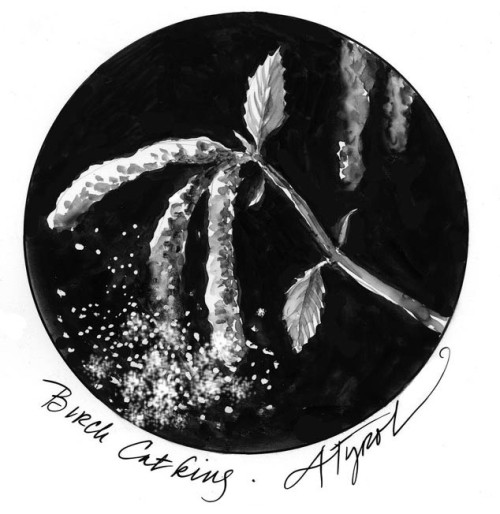
If you’re one of the 10 to 20 percent of the population who’s afflicted with seasonal allergies, you know that spring is in the air – literally. While the itchy eyes and runny nose you’re experiencing are classic hay fever symptoms, grasses have yet to flower. The allergy season is getting an early start thanks to other, less obvious blossoms.
Blame not the harmless pollen grain, but rather an antibody known as immunoglobulin E (IgE). IgE evolved to protect us from parasites, but some people are so sensitive to foreign substances that their body makes IgE when confronted with pollen. When IgE meets pollen in an allergy sufferer’s airways, it causes tissue mast cells to release histamine. The result – swelling, itching, sneezing, and mucus production – is good for ejecting parasites, but also a source of misery.
The pollen-shedding culprits are everywhere. Most trees in the Northeast rely on the wind to waft their pollen from male to female flower parts. These trees flower in early spring, before leaves unfurl and get in the way of pollination. Wind pollinated trees have pollen grains that are tiny, dry, and light. At about 25 microns long, it takes about 40 pollen grains, lined up end to end, to equal one millimeter. That’s a handy size for blowing about, and for penetrating nasal cavities.
Because they don’t need to attract bees, wind-pollinated flowers are generally greenish with scale-like petals. In many trees, such as oak, beech, and birch, the pollen-producing male flowers are massed on dangling catkins while the female flowers are separate. The anthers, the business part of the male flower, hang in the breeze and release millions of pollen grains. These vast numbers increase the likelihood of a pollen grain randomly blowing onto a female flower.
Female flowers can be easily overlooked on some trees. In red oak, for example, they are grouped on bud-like protrusions – each female flower is a mere one-eighth of an inch across. Large or small, what female flowers of most tree species have in common are feathery extensions, called stigmas, which catch airborne pollen.
Generally, we don’t see tree pollen, with the exception of white pine. Its yellow, cone-shaped male flowers release large pollen grains in enormous quantities that can be seen drifting in clouds, making a visible layer on windshields and puddles. Pine pollen grains are three to four times larger than those of most other trees, due to a pair of inflated air sacs that help the pollen stay airborne.
Although it looks like the perfect recipe for a sneeze, pine pollen doesn’t cause allergies. Oak, ash, and box-elder pollen provoke the strongest allergies.
While most trees are wind pollinated, 90 percent of flowering plants take advantage of insect pollinators. They produce typical flowers that lure insects in with bright colors, perfumes, and nectar in exchange for taking their pollen away and depositing it on the female parts of another flower. But allergy sufferers fear not: pollen from insect-pollinated flowers does not cause allergies.
Pollen from insect-pollinated flowers is designed to be readily picked up by an insect as it probes the flower for nectar. The pollen grains are big and rough, often revealing patterns of ridges or spines under the microscope. They are also covered in a viscous, oily fluid known as pollen kitt. This causes the pollen to stick together in clumps that adhere first to the insect and then to the prominently positioned stigma of the recipient flower. These sticky pollen grains don’t blow around like dust, so they don’t enter nasal passages and provoke allergies.
Despite being so tiny, pollen is more complex than it appears. It bears two sperm cells. After a pollen grain lands on a stigma, it germinates like a tiny plant and puts out a long pollen tube. This tube grows down into the flower’s ovary. Here it encounters an ovule, which holds an egg cell and a large central cell. The two sperm cells burst from the pollen tube. One fertilizes the egg cell, which develops into an embryonic plant, while the other fertilizes the central cell, which grows into a source of stored food called endosperm. This process is called double fertilization. The embryonic plant and the endosperm are packaged together into a seed that, with any luck, will reach the ground and grow into a self-sufficient plant, such as a rose or an oak tree.
Unfortunately for allergy sufferers, trees are just the first in the yearly succession of wind-pollinated plants. Soon there will be grasses, although only a handful out of a thousand or so species cause hay fever. Ragweed will later round out the season.
Although scientists have identified several pollen compounds that provoke the immune system to make IgE, the reason why only some people are sensitive remains poorly understood.

